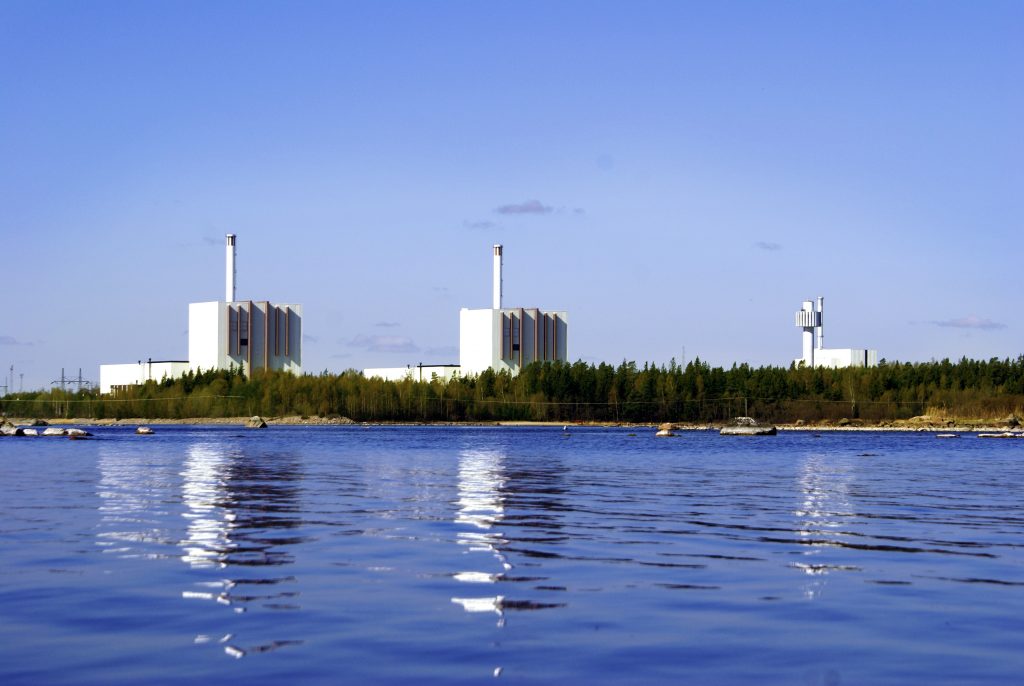
This is a report from August 2018. It is also available as pdf (0,5 MB)
Generally speaking nuclear power is insensitive to weather conditions, but there are cases when electricity production has to be reduced due to high sea water temperatures. It would be possible to adapt the reactors so that they may be operated at full power even when the sea warms. The reason for the existing temperature limitations is the economic optimisation on which the design of the reactor has been based. The cost of occasional production losses on warm summer days has been weighed against the increased costs of designing the plant for high sea water temperatures.
The electricity output from a nuclear power plant varies even when the reactor itself is operating at constant power. The turbine efficiency is dependent on the sea water temperature. The turbine is more efficient when cooled with really cold water, therefore the electricity production is the highest in the winter even though the reactor produces the same amount of energy all year round.
This text rather addresses the deliberate reduction of reactor power performed when sea water temperatures become unusually high. The text is translated from Swedish and describes how the Swedish reactors operate when sea water temperatures increase. The Swedish reactors are all located by the sea. Water temperatures are rarely above 20 degrees Celsius for longer periods. Many statements in the text are generally valid though some are more specific to the Nordic conditions.
Why is the power production reduced when the sea is warm?
When a reactor is shut down, the fuel continues to develop heat, referred to as decay heat. The amount of decay heat depends on the power that was being developed in the reactor before it was stopped. The higher that power was, the higher the decay heat will be. Decay heat must be removed at all times to avoid overheating the reactor. Reactors are equipped with a number of systems which – independently of each other – have the task of transferring this heat from the fuel, via heat exchangers, to the sea.
How efficiently heat can be transferred depends on the capacity of pumps and heat exchangers, i.e. how much water can be circulated in the cooling systems, and on the difference in temperature between the sea water and the water in the reactor cooling systems. When the sea is cold, the heat exchangers have very high cooling capacity but when the sea is warmer the capacity is lower.
When sea water temperature starts increasing, the cooling capacity of the reactor system is reduced. At some point a limit is reached where cooling capacity has dropped enough to match the decay heat that would be produced should a shutdown occur. At this point, the reactor power – and thus the electricity production – must be reduced accordingly. For some reactors other cooling systems define the limit e.g. the cooling circuits for the emergency diesel generators. The principle is the same though. By lowering the reactor power the need for cooling in case the reactor has to be stopped is reduced. Thereby warmer cooling water may be accepted.
Reactor operators in the power plant control room are trained on this issue and refer to graphs depicting the highest allowed reactor power as function of sea water temperature. The curve is different for different reactors, but at some temperature above 20 degrees Celsius the reactor operator starts reducing the reactor power. This reduces the steam flow to the turbine which leads to a reduction in electricity production. Would the sea water temperature continue upwards, the reactor power (and the electricity production) is further reduced. But as soon as the sea water temperature drops the control room staff begins to raise the reactor power again..
Why is this the case?
When the reactors were designed a number of decisions were made on the size of heat exchangers and motors in the cooling systems. Large heat exchangers and motors have high capacity, but are expensive and take up a lot of space. Small equipment may not be able to meet the need when the sea water temperature is high.
The design chosen is the result of economic optimisation where the risk of production losses due to high sea water temperature has been weighed against investment and maintenance costs for larger components. Historical sea water temperature data was used as input for the assessment.
Nordic power demand used to be low in the summer time. Production losses in the summer did not have large consequences. But as the share of photovoltaic and wind generation in the electricity mix increases this is changing. As electricity production is more dependent on the weather than it used to be, it is not at all unusual to see power prices in the summer that we previously only had on cold winter days. Loss of nuclear production may today lead to greater economic losses for plant owners than it used to.
As the average temperature of the planet increases the probability of high sea water temperatures becomes higher. Historic temperature data used for the optimisation of the nuclear power plants may no longer provide a valid estimate of future sea water temperatures. Combined with changed electricity prices in the summer time, the basis for the plant optimisation is changed. It may well be the case the capacity of the cooling systems is no longer economically optimal.
What may be done?
Essentially three things may be done to allow the reactors to operate at full power even at high sea water temperatures.
-
First, the cooling capacity of the reactor systems may be recalculated. Since the reactors were designed calculation tools have become more refined. More detailed answers may be provided than were possible before. In addition, our idea of the performance of the components and the system overall had to be based on the specified design as well as certain assumptions, with large margins built in for safety. Now, there are many years of operating experience to learn from and we know how components and systems behave in the real world. Performing more detailed and realistic calculations is often the simplest way to change the temperature limit.
-
Secondly, the cooling systems may be altered so that bottlenecks are removed. When a limiting component is replaced, something else sets a new limit which is slightly higher. By making further replacements the limit may be moved even further. These kinds of changes have been performed on many occasions at Swedish nuclear power plants. They do however mean reconstruction and extensive engineering work to predict how the plant will behave after alteration, which makes these kinds of changes costly.
-
Redesigning cooling systems addresses the issue by increasing the cooling capacity. More water may be circulated which reduces the need for low cooling water temperatures. The third way to increase the capacity is to make sure there is access to cold enough cooling water. Along the Swedish coast cold water is always available at sufficient depth. Building a deep water intake is the most expensive way of managing the temperature limitations. But it is also the most far reaching way of dealing with the issue as it has the potential to completely eliminate the problem.
Whether any of this should be done at the Swedish reactors is entirely a matter of economic optimisation. After all, the production lost due to warmer sea water is rather limited. The reactor power is rarely reduced. The investments involved are significant however. There is also generally a justified resistance to making changes in the reactor safety systems. Therefore it is probable that the economic benefit of undertaking a plant alteration would have to be great.
What is the situation in other countries?
Most reactors worldwide are located by the sea and cooled with sea water. They generally have the same situation. In the cases where they are located next to a warm sea they have obviously been designed for higher sea water temperatures. But limitations in the temperature of sea water for cooling exist everywhere.
Reactors cooled by river water are in a different situation. The operation of these reactors is governed by legal requirements limiting the heating of the river. If the cooling water released to the river becomes too hot, the reactor power has to be reduced to avoid heating the river above the allowed limit. In this case the reduction in reactor power is not associated with the safe operation of the plant but rather to the effect on the local environment (the river). In Sweden this is not an issue since all the reactors are cooled by sea water. The temperature of the sea is not affected more than locally regardless of the temperature of the emitted cooling water. The effect on reactors in continental Europe can sometimes be significant.
Some reactors have cooling towers and hence use the atmosphere instead of the sea or a river to get rid of heat. Even these have their cooling systems optimised towards some maximum air temperature. If the air becomes warmer, the reactor power has to be reduced.
Author: Daniel Westlén – Vattenfall
Scrutiniser: Claes Halldin – Uniper
Photo: Christoffer Ågstrand – Forsmark Nuclear Power Plant

